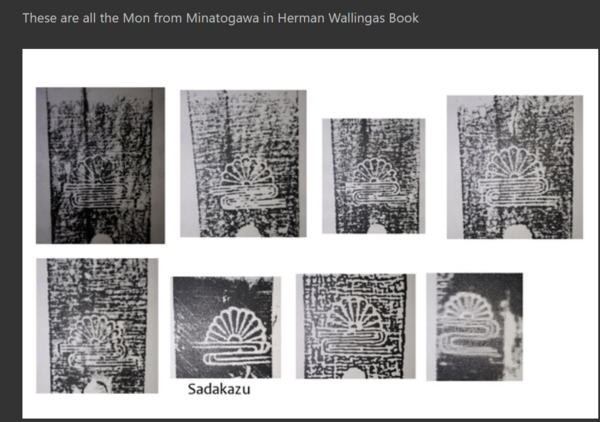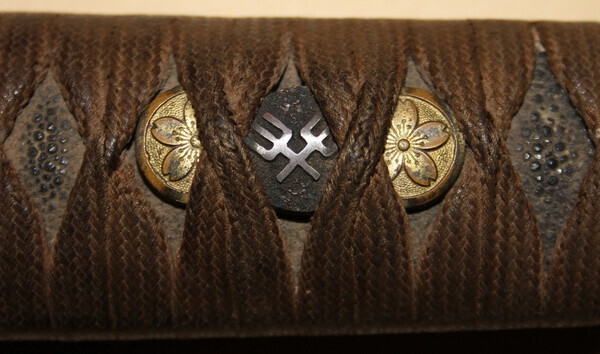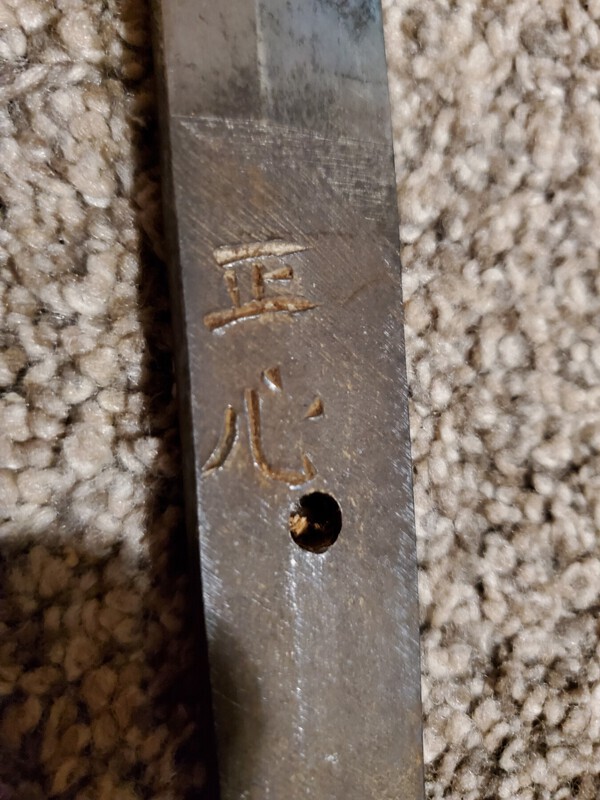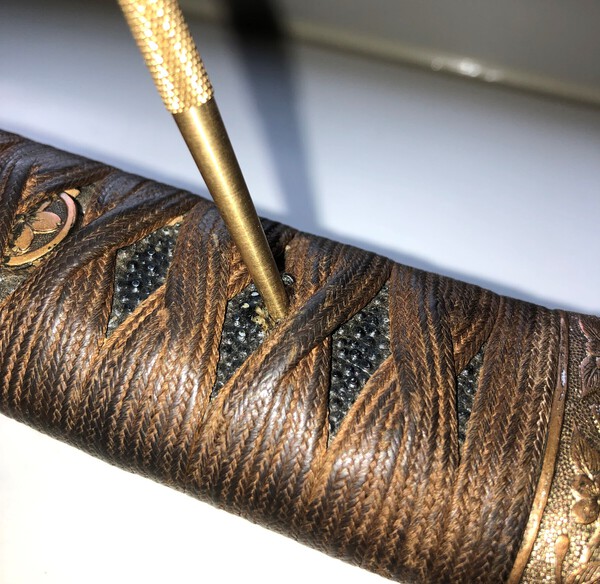-
Posts
13,061 -
Joined
-
Last visited
-
Days Won
157
Content Type
Profiles
Forums
Events
Store
Downloads
Gallery
Everything posted by Bruce Pennington
-

newly found Minatogawa Jinja katana
Bruce Pennington replied to baldi1942's topic in General Nihonto Related Discussion
My 2 cents on the kikusui -From Herman Wallinga's book. The Sadakazu one shows a hand-crafted one that is, in my view, even less skilled ( I'm trying not to say poorly crafted!). We found on an other Minatagawa thread (HERE) that there is quite a lot of variation of these emblems. They were not a fixed stamp, but hand-cut, so artist conception and skill vary for all of them. Second one, bottom row: -

please help with information on my grandfathers sword
Bruce Pennington replied to Mike T's topic in Military Swords of Japan
This is what George Trotter said about him: "The Yanagawa brothers of Saitama had been making swords in their shop in Suginami, Tokyo (next to Shinjuku) since Meiji Taisho times, (mainly sabres etc which they "signed" with a stamp "Naotsugu"). Their "brand" name was "Shoshin". In WWII they must have also been making gendai which the signed with the usual "cut" mei...usually SHOSHIN or USHOSHIN. " -
Picture Please! I wish we could pin down the shop that was stamping numbers rather than using paint. But they seem to be affiliated with higher-end blades. Maybe it was considered "classier" by the shop owner.
-

The Japan news ticker
Bruce Pennington replied to Brian's topic in Forum Technical Details and Maintenance
Third choice: Doesn't matter to me either way. "check" -
It might take a while, but that can be part of the fun of the hobby. It took me 2 years to find all the parts that were missing on my dad's Mantetsu. But it's worth the time and effort. In the end, you wind up with a really good looking gunto and the pleasure of making it all happen.
-
Bobby, You have a Japanese officer sword (Type 94 or 98, can't tell without pictures of the full saya (scabbard). Someone will help with the smith's name. More pictures of the full blade, and close-ups of the blade tip and a section of the blade showing the temper line, will help tell more about the blade.
-
Thanks Neil, any other inspector stamps on it?
-

Attention Mantetsu Owners: A Survey
Bruce Pennington replied to Bruce Pennington's topic in Military Swords of Japan
Thomas, I hadn't made that connection! Are you seeing the "TO" on the kabutogane of the "M" stamped blades? -

Attention Mantetsu Owners: A Survey
Bruce Pennington replied to Bruce Pennington's topic in Military Swords of Japan
Thanks David! I'm glad we looked further on that, as it is クKU. And it fits better as all the other Ku are Autumn blades too. -
-

Why are Mon so rare on Kai Gunto?
Bruce Pennington replied to PNSSHOGUN's topic in Military Swords of Japan
Barry, Richard Fuller says that is the Toyokawa Navy Arsenal stamp on fittings. It might be, but I'm starting to investigate the idea that it's an actual stamp from a koshirae shop, associated with the arsenal, sure, but a separate shop like Tenzoshan was. The Toyokawa stamp on blades is an anchor in a circle, not a sakura. Thanks for the nice example! -
OK, after seeing the rest of the pictures, it is clear that Tsuka was never fitted for that blade. Matching numbers on the saya, so that’s good!
-
That's what I thought. With mixed items like this there are usually 3 choices: 1. All original, 2. G.I. has a gunto with missing parts, scrounges the sword piles to find stuff to fit, and 3. Post-war piece-together. Since you know the full story of this one, Choice 3 is out, leaving the first two. The most obvious choice is #2 - he picked up the gunto, missing parts, and scrounged around to find some that fit. The small black seppa is correct for a late-war Type 95, so we only have the tsuba and tsuka to wonder about. I haven't seen a habaki. Is there one, or is it missing? If it's missing, it could explain why the mekugi ana don't line up. I'm plagued by the shortened nakago, though. There was a program early in the war for officers to buy Type 95 (or rent) gunto because of shortages. What little we know of the program, though, makes is seem to be during the early years. I haven't heard of it lasting into the end of the war, but that doesn't mean it wasn't still being done. This, to me, has the appearance of a blade that was intentionally shortened to take the officer tsuka (and Oh, BTW, it's got an officer tsuka on it!). Another purely speculative idea is that an NCO, just graduating from officer candidate school, had his 95 modified for the officer handle. But I'm WAY into pure speculation. All we know, in fact, is you have a late-war Type 95 with a modified nakago and an officer tsuba and tsuka! And you know some Bubba didn't do this to the sword post-war.
-

Attention Mantetsu Owners: A Survey
Bruce Pennington replied to Bruce Pennington's topic in Military Swords of Japan
David, Thanks for adding your blade to the study! Of the 9 " ウ" numbers, yours is the first "Autumn", the rest are all "Spring". Forgive me for being anal, but could I get a picture of the full serial number that would show the ウ, please!? Yours is interesting too, because it looks like the number was mistakenly marked "4 4 6" and realizing his error, struck over the second 4 with a 6! -
Mike, Thanks for the photos! Could I get one more of the tsuba (hand-guard) laying by itself? So, the blade IS a late-war Type 95 NCO blade, made by Seki shops for the Nagoya Army Arsenal. The saya is correct and likely original to the blade. The end of the nakago (tang) has been cut off, and the original handle (tsuka) should be wooden. I have one just 2,000 numbers earlier than yours (211894 Seki) and I'm posting pics of the tsuka and nakago for comparison. It's possible yours took some battle damage and the repair team cut the end off. Many of these war trophies came home missing parts. If the tsuba (hand-guard) is correct, then all you're missing is the tsuka.
-

please help with information on my grandfathers sword
Bruce Pennington replied to Mike T's topic in Military Swords of Japan
Chevy, Please go to your settings, and put in a first name that will show up on all of your posts. It’s forum rules, and we are just used to having a real person to talk to rather than a screen name. Thanks. SteveM gave us the name in a post above. It’s “Seishin (or Shōshin)”. He is an obscure Sword Smith, and no one really knows which pronunciation is correct. -
Fabulous Steve, thank you! Edit: Just saw that you posted this answer on the other thread! Sorry for the double hit on this!
-
So, Steve, what do you think about this one? It doesn't have the 右, just the 正心. It's on a shingunto on This Thread
-

please help with information on my grandfathers sword
Bruce Pennington replied to Mike T's topic in Military Swords of Japan
Is the saya (scabbard) aluminum? If you have a magnet, see if it sticks. -

please help with information on my grandfathers sword
Bruce Pennington replied to Mike T's topic in Military Swords of Japan
Sometimes the guys that can translate cruise through. If they don't in a day or so, bring the mei over to the Translation Assistance Forum. Your metal parts have some residual "silver" in the crevasses, and have that same dark look you see on the plated ones. Neil (IJASWORDS) posted some that have that same look, on another thread. -

please help with information on my grandfathers sword
Bruce Pennington replied to Mike T's topic in Military Swords of Japan
What about 正広 (Masahiro) -

Suggestions
Bruce Pennington replied to Grey Doffin's topic in Forum Technical Details and Maintenance
Brian, I opened 2 tabs, keeping your instruction steps on one and using the other to go through them and it worked nicely! Thanks! I've found that as I'm reading each item on my stream, all I have to do to get back to my stream is hit the "Back" arrow rather than the 3 steps it takes to go back to the top, open Activity, My Activity Streams, and My Stream. Hitting the Back arrow gets me back to my stream, and it's even updated with the fact that I've just read the item at the top and has moved on to the next item. Thanks! -

please help with information on my grandfathers sword
Bruce Pennington replied to Mike T's topic in Military Swords of Japan
The hole you see in the handle should have a bamboo peg (mekugi) that can be puched out. The tsuka (handle) slide right off after it's removed. If there isn't anything in there, then the tsuka is just wedged on because of the missing tsuba/seppa, and can be convinced to come off. The official way is to hold the sword upright in one hand and firmly smack your wrist with your other hand to jar the tsuka loose. I have had mixed results with this method depending upon how tightly rusted or jammed it is. If it doesn't work, tapping with a rubber mallet seems to do the trick. -
Neil, The model has all the appearance one would expect of a "late-war", "just so it stabs...", design - yet the brass menugi rather than steel. Wonder why, considering the original intent was to avoid brass? Seems almost out of place! Oh, and you BETTER be working on a book!







